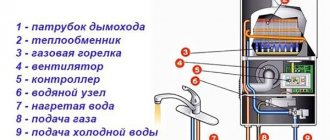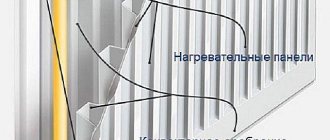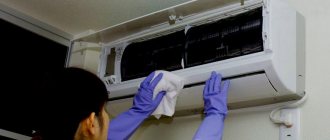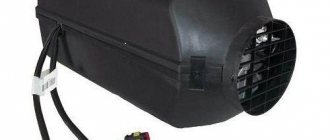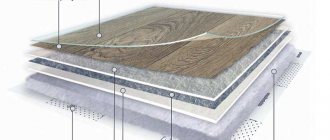Although models with the “heat-cold” function are very popular among buyers, many do not think about turning on the air conditioner for heating and use it only in the summer. However, at a time when it is getting cold in the Krasnodar Territory and the central heating has not yet been turned on, it’s time to remember the functionality of such widespread climate control equipment, which is probably already installed in your house or apartment, or you are planning to purchase it. Yes. Your air conditioner is most likely capable of providing your home with comfortable, cozy warmth.
After reading the article, you will learn:
- The best off-season offer!
- Is it possible to turn on the air conditioner for heating?
- Why is heating with air conditioning cost-effective?
- When can you turn on the air conditioner for heating?
- How to properly turn on the heating mode on an air conditioner?
- How to turn on the air conditioner for heating using the remote control?
- How to turn on the air conditioner for heating without a remote control?
- Is it possible to turn on the air conditioner in winter (heating)?
- At what temperature should you turn on the air conditioner for heating?
- What to do if the heating does not turn on?
Is it possible to turn on the air conditioner for heating?
When cooling, the indoor unit of the air conditioner is the evaporator, and the outdoor unit is the condenser. In this case, heat is released from the external unit. The heat released is a consequence of the “cooling” process; additional energy is not spent on heat transfer. If you swap the functions of the indoor and outdoor units, and make the evaporator the external unit, and the condenser the indoor unit, then the air conditioner will work very economically for heating. How to do it?
The cooling and heating processes occur due to the compression and expansion of the refrigerant leaving the compressor and flowing through special tubes in a certain direction. The four-way valve in the outdoor unit of the air conditioner switches the heat and cold modes from one to the other, causing the refrigerant to flow in the opposite direction. As a result, the functions of the indoor and outdoor units are reversed and, accordingly, the air conditioner mode switches from cooling to heating.
That is, the answer to the question: “is it possible to turn on the air conditioner for heating” will be the following. If your air conditioner has a four-way valve, then you can. As a rule, the instructions for the model will indicate, among others, the “Heating” mode.
Features of space heating with split systems
When purchasing an air conditioner, consider the weather conditions in your area. To heat your home in an average climate, choose equipment designed for operation at temperatures from -15°C and below.
For heating the premises in winter, inverter air conditioners from the brands Daikin, Panasonic, and Mitsubishi are produced. The design of the models of these lines allows you to effectively heat your home in winter in countries located in northern Europe. They provide a continuous supply of warm air thanks to the accumulation of waste heat by the compressor.
Install a winter start device on a regular split system using the services of a service center. The winter kit will prevent premature wear of the device parts and increase its performance. To switch the air conditioner from cooling to heating mode, use the buttons on the device's control panel.
If warm air does not start flowing within 15 minutes, check that the settings are correct. If necessary, reset the settings and switch the split system back to the “warm” mode, following the sequence specified in the instructions for the equipment. The correct choice of air conditioner model and compliance with the operating requirements of the device will ensure the convenience of maintaining a comfortable room temperature throughout the cold season.
Why is heating with air conditioning cost-effective?
An air conditioner is able to “extract heat” from its environment by condensing liquid in the air it draws in. How does this happen? Freon condenses in the thermoblock under high pressure. Liquid freon enters the outdoor unit, where the pressure drops sharply, turning the freon back into gas.
So, 2-3 kW of heat obtained from the environment and 1 kW of electricity provide a total of 3-5 kW of heat for heating the room. We get at least 3 times more energy than we spend. Profitable, isn't it?
Features of the air conditioner when switching
When the split system is turned on for heating, some time must pass before the air warms up, since cool air enters the system first.
Therefore, the user should not mindlessly press the heating button again and again, or impatiently switch between modes. Such actions will only harm the system. The user needs to be patient and wait until the system starts heating the room.

How to turn on the air conditioner for heating using the remote control?
To turn on the heating function on an air conditioner using the control panel, regardless of the model, you need to follow a few simple steps:
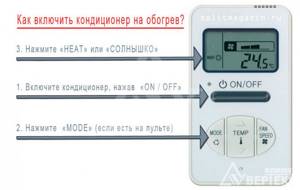
- Take the remote control for your air conditioner and turn on the device in normal mode, i.e. Press the ON/OFF power button.
- There should be a “MODE” button on the remote control. Press it and switch modes until the “sun” icon or “HEAT” appears on the screen.
- Press the HEAT key (or the sun icon). This will allow you to switch the split system to heating mode and heat the room to 30ºС.
- If your remote control does not have a “MODE” button, look at the buttons with the “snowflake”, “fan”, “droplet”, “sun” icons. Click "sun". If there is neither “sun” nor “NEAT” on the remote control, but other modes are displayed, then your air conditioner does not support the heating function.
- Pay attention to the buttons marked “+” and “-”. They allow you to adjust the temperature from 1ºC and above. After using them, set the conditions that are comfortable for yourself (the set temperature should be higher than the one that currently exists in the room). Or use the up and down keys.
- Be sure to wait about 5-10 minutes. Warm air will not come out immediately. First the fan turns on, then the air begins to heat up. But pay attention, the device must respond to your actions (beep, blink, turn on / off).
You can, on the contrary, first set up the heating on the remote control and only then turn on the air conditioner (press the “ON” button). For some models, this order is considered correct.

Instructions for the control panel and Akvilon air conditioners
Aquilon systems have an emergency start mode; the button can be used if the remote control is lost or the batteries are damaged.
The remote control display is a window at the top of the remote control, which displays the operating values of modes and temperatures. The top row of controls consists of 3 buttons:
- “Display” - turns on or off the display window while the system is running.
- “Medium” - turns on the “Sleep” function.
- “Swing” - changes the position of the vertical sashes.
In the middle part of the remote control there are two buttons with arrows to regulate the temperature.
With the help of the rest they manipulate the modes:
- “Turbo” - used to accelerate the set temperature;
- The “Timer” button must be activated to set the timer;
- The lower middle button adjusts the time;
- "Fan" is used to set the fan speed;
- “Lock” locks the remote control;
- “Quiet” sets the operating mode with low noise;
- “Reset” reboots the remote control for the air conditioner, and all settings are reset.
The “Mode Selection” button sets the operation of the system - auto, heat or cooling, dehumidification or ventilation.
A manual is included with each model. If you need to clean, refill or repair your air conditioner, you need to contact a specialized workshop. Independent intervention in the event of a malfunction can lead to incorrect operation, breakdown or accident.
How to turn on the heating mode on an air conditioner (without a remote control)?
If for some reason you do not have a control panel, you can turn on the heating function on the air conditioner itself, more precisely, using the control panel located on the body of the indoor unit (on a number of models such a panel is hidden, see the instructions).
So, to turn on the air conditioner for heating without a remote control, follow these steps:
- Turn on the air conditioner.
- Find the sun icon on the display and press.
- Wait about 5-10 minutes.
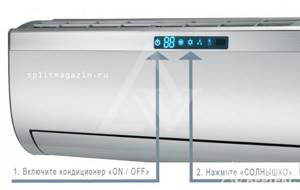
If you have lost your “original” remote control, buy a universal remote control that is also suitable for your split system.
Things to consider

Climate control equipment has several useful options:
- Cooling mode.
- Heating.
Manufacturers add other functions to various models.
Many models of split systems support an automatic mode, which independently selects the desired operating option, focusing on microclimate parameters: temperature (internal and external), humidity, etc. If this is not provided, you need to take into account some nuances before switching modes yourself.
Is it possible to turn on the air conditioner in winter (heating)?
You can, of course, turn on the air conditioner for heating in winter, if it has such a mode. But you need to take into account the temperature limitations and capabilities of your model. In order for the air conditioner to function normally at low temperatures even in winter, it is necessary to equip the external unit with the so-called “winter kit”, which is based on the RDC device and heaters. The winter kit prevents the formation of ice on the external unit and inside it, and helps remove moisture from the evaporator unit.
By installing the winter kit on the air conditioner, you can use it in heating mode even at -20ºС outside the window.

Advantages of heating with air conditioning:
Energy Saving
Heating with electric heater
A classic electric heater consumes approximately 1.5 kW to 2 kW to heat a room of 15 sq.m. Heating will not be uniform and the air temperature next to the heater will be significantly higher than that in other parts of the room, and therefore the heater operating mode will be set to a higher temperature than required. The time during which an electric heater is able to bring the room temperature to a comfortable temperature for a person can exceed 1 hour.
Air conditioning heating
Electricity consumption by an air conditioner in heating mode for a room of 15 sq.m. no higher than 0.7 kW. H., that is, more than 2 times lower. Such low energy consumption seems impossible if you do not know how the air conditioner works for heating. The air conditioner itself does not produce heat, it only delivers it to the room through heat exchange. The same principle as for cooling, only in reverse. Heat is taken into the premises from the street, and cold is removed outside. Electricity consumption occurs only for the operation of the compressor and fans.
Heating the apartment in the off-season.
In the off-season, when the central heating is still turned on, and the temperature outside is already below 10 degrees, you have to turn on the heaters. Although this time does not exceed one month in the fall and is possible with early frosts in the spring, in combination with summer cooling this is an additional important argument in favor of installing an air conditioner in your apartment. In addition to high energy efficiency, such a functional ability of the air conditioner as automatic operation of maintaining the set temperature in Auto mode is very pleasant. You just need to turn on the air conditioner for heat or cold, set a temperature that is comfortable for you, and maintaining the temperature will no longer require your participation.
Difficulties with heating in a dacha
A country house is a place where living is seasonal and expensive capital heating is rarely required. In addition, the lack of gasification in gardening communities makes heating not a cheap pleasure. The high price of heating imposes a limit on electricity consumption due to a lack of capacity, which makes heating with electric heaters impossible. Loaded networks are also subject to voltage drops.
Country heating with air conditioning
In country houses, where most often the walls consist of lightweight structures insulated inside and decorated with decorative finishing inside and outside. Such walls work well to control temperature, but do not accumulate temperature in any way. For this reason, a constant heat source is required. This makes inter-seasonal heating of the entire house at the same time costly, and even unnecessary due to non-permanent residence. Installing air conditioners in different rooms makes it possible to set different temperatures, which provides an additional opportunity to save energy. Along with the low cost of heating with air conditioning, the speed of bringing the temperature to a comfortable level is also important. Due to the ability to pass a large volume of air through the heat exchanger, the air in the room quickly heats up
Some air conditioners have a protection function against voltage surges, which is also important in holiday villages with unstable power supplies
Disadvantages of heating a room with air conditioning
A significant disadvantage of heating a room with an air conditioner is that prolonged operation of the air conditioner in this mode at street temperatures below 0 degrees is not desirable. Even if you read in the instructions that the air conditioner works, for example, up to - 10, then this is not entirely true. Operation at sub-zero temperatures involves heating the condensate drain. This is mainly due to the fact that condensate during the “heating” mode forms in the outdoor unit and, when drained, freezes in the drainage outlet, forming a plug. After which the ice freezes inside the outdoor unit. Ice freezing can damage the fan. In addition, at low temperatures the energy efficiency of the air conditioner decreases. If your air conditioner is not specifically designed by the manufacturer for low temperatures, then prolonged operation in heating mode at street temperatures below -7ºC will inevitably lead to its breakdown.
Heat pump - air conditioner for heating
Heat pumps are essentially the same split systems, but are specially adapted to operate at very low temperatures. There are heat pumps on the market that can operate at -25°C, -30°C, and even down to -40°C. Read more about heat pumps.
If my article helped you, please rate it on social networks.
At what temperature should you turn on the air conditioner for heating?
The permissible lower temperature barrier of ambient air for air conditioners operating on R-22 refrigerant is -5 ºС, for R-410A up to -10 ºС for non-inverter models, and up to -15 ºС for inverter models. At lower temperatures, compressor oil freezes and ceases to dissolve in the refrigerant, which leads to a “dry start” of the air conditioner, which can further lead to compressor failure. To operate air conditioners for heating at lower temperatures, it is necessary to install a “winter kit”. We recommend turning on the air conditioner for heating when the ambient temperature reaches 0ºС. When starting the split system for heating, pay attention that the outdoor unit is not icy, because... in this case, there is a risk of damage to the fan of the external unit. When the split system is operating for heating below the minimum permissible ambient temperature, be sure to service the air conditioner before starting the air conditioner in the cold, because You may need to top up with freon.
Impact of installation on system operation
It is wrong to assume that the split system will work properly, regardless of who installed it and how. But no. Installing such a complex device is a rather complicated process. It has its own nuances and tricks that you need to know and take into account.
Since the device itself is not a cheap pleasure, it would be strange to save on its installation rather than safely ruin it.

One of the nuances of proper installation of a split system is the installation of such a visor, which can protect your expensive device from precipitation and sunlight
Errors made at the installation stage can lead to insufficient heating of the space when the device is supposed to work for heating. One of the common mistakes is improper organization of air circulation. Air masses must not only have unhindered access to the system, but also free outflow from it.
You should pay careful attention to the following installation points:
- the external unit should not be flush against the wall: it must be secured at a sufficient distance using brackets or anchors;
- The strictly horizontal installation of the block should be checked using a building level;
- for the air conditioner it is better to provide a separate circuit breaker on the panel and its own cable;
- protect the external unit with a special canopy from precipitation and direct sunlight;
- moisture should not stagnate inside the system, which means that the drainage tube should be installed at an angle;
- there may be a certain height difference between the indoor and outdoor units, but within reasonable limits: no more than 20 m;
- It is better not to install the indoor unit directly above radiators or other heat sources; there cannot be curtains in the air path, and there must be at least three meters between the device and the furniture;
- Avoid positioning the device in such a way that the air currents emanating from it will be directed directly at people - it’s easy to get pneumonia in such conditions, even in the summer heat.
Do not wait for breakdowns or other incomprehensible situations to start studying the Instructions. Knowing the features of your purchase, the rules of its operation and the nuances of caring for it will help you use it not only for a long time, but also for your health and not to its detriment.
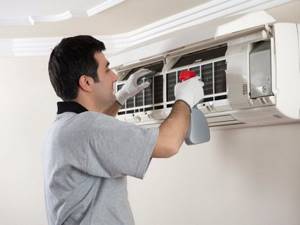
Timely and professional care of the air conditioner extends its useful life and helps maintain the health of all residents of the house where it is used.
Cleaning the device, changing its filters or refilling the refrigerant are the functions of a specialized organization. Do not try to repair the air conditioner yourself - it is dangerous. Turn off the power and invite a repairman.
However, if you are used to doing everything yourself and are confident in your own abilities, then we advise you to first study the rules for servicing split systems.
What to do if the heating does not turn on?
Have you done everything correctly, waited 5-10 minutes or even more, but the air conditioner still does not heat the air?
- Check the instructions to see if your model has this mode? Even if there is a “sun” or HEAT on the remote control, this does not mean that the air conditioner will help heat. Manufacturers often use standard remote controls for all of their devices.
- Repeat the steps from the beginning, carefully reading the original instructions and listening to the reaction of the split system. 10-15 minutes after turning on, raise your hand to the device and check if heat is coming out of it.
- If the SUN/HEAT buttons flash when you press them correctly, change the batteries on the remote or simply remove them and reinsert them.
- If there is a heating mode, but does not work, then perhaps there is not enough freon in the split system. Contact the service center that serves you, or call our company, we will help you figure it out.
Air conditioners: general information and classification
Human health, performance and quality of life depend on the state of the environment. So that external disasters have less impact on us, we create our own comfortable microclimate in the rooms where we sleep, live, and work.
The creation, use and improvement of air conditioning is humanity’s response to nature, its way of protection.
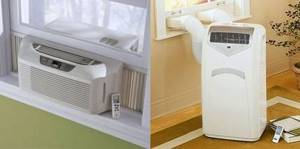
The window and portable monoblocks include only one block, which contains all the elements of the device that allow it to perform its functions
Most modern models of this device are familiar to us:
- window and mobile monoblocks;
- split systems.
In turn, split systems, consisting of outdoor and indoor units, are divided into:
- Wall-mounted. This option is most often used in offices and residential premises.
- Columned. They look like powerful columns and are used in conference rooms, restaurants and hotel lobbies to supply air into the ceiling space and then distribute it.
- Ceiling. The air flow from them is directed along the ceiling or wall. They consist of an indoor unit and an air duct system for flow distribution. These are predominantly cassette options installed in the attic or hidden behind suspended ceiling systems.
Multisystems are used to process large objects. They are characterized by the presence of one common outdoor unit and several indoor units connected to a common outdoor unit and located in different rooms.
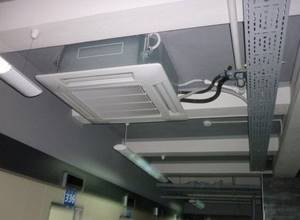
We are used to seeing wall-mounted split systems, although the range of these devices is very wide, for example, this is what cassette air conditioners look like, which are built into the ceiling of a large store or warehouse
Main characteristics that distinguish one model from another:
- power consumption;
- performance;
- acoustic comfort;
- a set of functions included in the model: cooling, heating, air ionization, dehumidification, cleaning, etc.
Prices for models from different brands depend not only on the listed characteristics, but also on the class of the device.
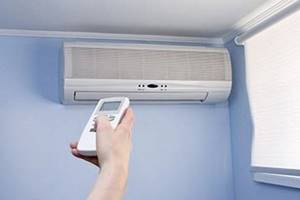
The wall-mounted split system familiar to our eyes consists of two blocks and is equipped with a remote control, which controls its functions.
All models can be divided into three classes:
Regardless of what class a truly modern air conditioner can be classified into, it must be:
- equipped with a remote control;
- not only cool, but heat and dry the air;
- work in ventilation mode;
- maintain the specified operating parameters in automatic mode;
- have an on/off timer.
By the way, cooling and heating are two sides of the same process that occurs in a split system.
Possible problems due to improper use
Reduced efficiency (remember that we are talking about heating mode) is not the only problem
It is very important for the compressor that the refrigerant in the evaporator actually evaporates and enters the suction pipe in a gaseous state. What will we get if we warm ourselves with air conditioning in severe frost?
The refrigerant entered the evaporator (as you remember, it is located outside in heating mode), but due to the extreme cold it was unable to heat up and remained in liquid form. In this state of aggregation, it enters the compressor. A hydraulic shock immediately occurs and the supercharger fails.
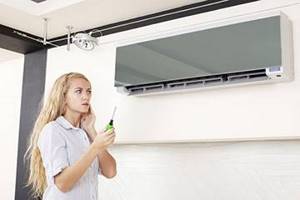
Let's return to cooling mode. There is also a hidden threat here: the condensate running down the drain pipe can freeze, resulting in an ice plug in the line.
The moisture will have nowhere to go, and it will begin to pour out of the indoor unit of the air conditioner. This in itself is unpleasant, but in addition, the abundance of moisture combined with dust creates excellent conditions for the proliferation of pathogenic microorganisms.
Users begin to feel an unpleasant odor coming from the indoor unit. This phenomenon can only be eliminated by sanitizing the radiator and other elements of the indoor unit. It will also be necessary to restore the functionality of the drainage system.
Let us remind you once again about the third danger - excessive thickening of the lubricant. By the way, lubricant may not enter the compressor even at normal temperatures. Sometimes, for one reason or another, the outdoor unit has to be placed much lower than the indoor unit, as a result of which the freon pipeline connecting them has a considerable length. Under such conditions, oil vapors settle on its walls and flow down, so that the refrigerant enters the compressor without lubrication.
To prevent this phenomenon, oil traps are installed in the freon pipeline. Each of them is a simple loop in which the oil flowing down accumulates and forms a plug. The freon pumped by the compressor pushes through this plug and thus helps it overcome the altitude barrier.
Problems not related to winter operation may also arise. For example, icing of the radiator in the indoor unit when operating in cooling mode. The user discovers this problem when, after turning off the air conditioner, water begins to flow from the indoor unit. The reason is clogged filters. They stopped letting in warm air from the room, which was warmed by the evaporator, and it began to freeze. By cleaning the filters, you will get rid of the problem.
Sometimes there is a gurgling sound from the air conditioner. This is due to the fact that the drainage pipe in some place does not have a slope or it is even reversed: condensation accumulates here, and the gurgling sound is produced by the air passing through it. Note that “gurgles” can also be heard in freon pipes. If this phenomenon is observed at the startup stage, there is nothing to worry about.
But if the sounds are heard constantly, then you should file a claim with the installer: most likely, the circuit was not evacuated before filling with refrigerant, and moisture remained in it.

